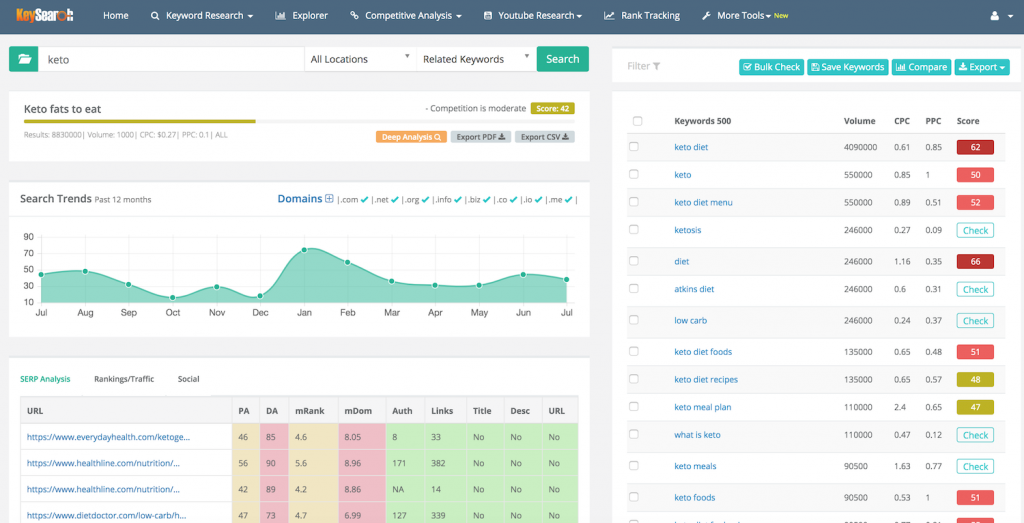August 2018 was a HUGE moment in business for The Unconventional RD.
Up until then, my blog and Facebook group had simply been hobbies.
I wrote blog posts sporadically and spent TONS of time interacting in the Facebook group, but I didn’t have anything to offer people.
The description of my blog & FB group was “a space for dietitians interested in passive and alternative income”, but I wasn’t actually providing any concrete guidance on these topics!
Sure, starting conversations & answering questions in blog posts or Facebook groups is great… but it’s just not the same thing as step by step help.
Sooooo, FINALLY, in August 2018, I decided to create a real product for my peeps – The Unconventional RD Business Bootcamp!
It was meant to be a series of 3 trainings that would teach RDs how to create passive income streams in their businesses.
At the time, I didn’t know exactly what topics I wanted to teach on, so I pre-sold the offer without even having the 3 training topics pinned down!
Because of this, only my truest of true fans invested, but it was enough to validate the idea and start creating it.
So, without further ado, let’s dive into my income streams for August 2018 🙂
Disclosure: Please note that this post contains affiliate links. This means that I will earn a percentage of any sales made through those links, at no extra cost to you.
August 2018 Income Sources
1. Products ($5,297.32)
-
- The Unconventional RD Business Bootcamp ($5,022)
- “Which EHR is Right For Me?” online course ($200)
- Fullscript ($75.32)
2. Virtual Services ($2,100)
-
- Freelance writing ($2,100)
3. Recurring Revenue ($1,586.27)
-
- Functional Nutrition Library ($1,586.27)
4. Affiliate Income ($27.04)
-
- KeySearch ($27.04)
5. Advertising ($16.18)
-
- Google Adsense ($16.18)
Total Income: $9,026.81
August 2018 EXPENSES
- Payments to Research Assistants: $525
- FNL Affiliate Payouts: $199.59
- Payments to Freelance Writers: $125
- ConvertKit: $78
- Books for Giveaway: $44.12
- Business Banking Fees: $37
- Hiscox Professional Liability Insurance: $33.37
- Business Email with G-Suite: $20
- Website Hosting with WPopt: $19.99
- Tailwind: $14.99
- KeySearch: $13.60
- Website Hosting with Cloudways: $12.80
- Domain renewal: $12.17
- Vimeo: $12
- Adobe Creative Cloud: $9.99
- Dropbox: $9.99
- SendGrid for Transactional Emails: $7.38
Total Expenses: $1,174.99
Net income: $7,851.82
INCOME OVERVIEW
I know that last month I posted all about the relaunch of the Functional Nutrition Library (yee!), but I wasted NO time diving right into my next big business project in August 🙂
Cause if I’ve learned anything over the last year, it’s that getting out of my own way and actually creating products for the world has been the biggest game-changer in my life and business.
If you’ve been following my journey, you also know how passionate I am about pre-selling products BEFORE making them.
I had quite a few product flops early on as a dietitian when I tried to sell before I had a niche or an audience (womp womp), and to be honest, it was really disheartening.
To avoid that, these days I always pre-sell my products.
This means that I create a page on my website with a description of what the product will be (with a focus on the transformation it provides for my customer), the price, and release date.
I open the cart for people to purchase at a steep discount (usually ~50% off) for a week or so to see if there is true interest in the product.
From there, 3 things could happen:
1) No one buys, and I simply don’t build the product.
2) Only a few people buy, but not enough to justify spending the time working on this project. In this case, I can refund my customers and let them know there wasn’t enough interest to move forward at this time.
3) A lot of people buy (I have a goal # in mind before I open the cart), and I’ve successfully validated the idea! I can confidently move forward with creating it.
This helps avoid spending day, weeks, or even months on a project, only to sell one or two when you launch. (Been there!)
If you want more guidance on setting up a pre-sale for your product, check out my “Make Money Blogging” course, which walks you through the art of pre-selling.
For this pre-sale, I did a 72 hour flash sale offering access to my upcoming 3 courses at a VERY steep discount ($279 for 1 year of access to ALL 3 courses).
At the time, I didn’t even know exactly what I would teach about or when, exactly, the courses would launch, but I had built up enough trust with my Unconventional RD audience that 18 people purchased and I made $5,022 in just three days!!
That was more than enough validation for me that there was interest in courses that would help dietitians create passive income streams.
Once the idea was validated with REAL people paying REAL money for it, the next step was to survey my customers to see what they were interested in learning about.
From that survey, I found that people were interested in SEO, blog monetization, online courses, and email marketing. Since I had been focusing on teaching myself SEO, I decided to start with that topic for course #1.
I’ll give you more details on that in later income reports!
If you’re curious about the tools I used to pre-sell my courses, here’s how I set it up:
- I set up a self-hosted website at a new URL (www.theunconventionalrdbb.com) that I would use just for hosting and selling courses. I decided to do this so as to not slow down my main blog’s website with bulky course plugins. I recommend this company for hosting.
- Used Divi as my theme to create my sales page.
- Used MemberPress to take payments through Stripe (a credit card processor).
- Used LearnDash to set up the courses.
- Used SendGrid to set up transactional emails (automated emails sent through MemberPress when people purchase).
- Used MailChimp to create an email list just for my paying course customers.
- Used Canva to create pretty graphics for the sales page
- Used Unsplash to download free pictures.
Hope that gives you a helpful idea of how to get started!
In other news… I also set-up agreements with a couple of other RDs who were interested in sharing my “Which EHR Is Right for Me?” e-course with their students.
They agreed to pay a discounted bulk rate for the courses in exchange for allowing their students free access 🙂
So if you sell professional development courses, keep this arrangement in mind as a way to collaborate with other RDs in your space!
August was also a great month for freelance writing.
At the time, I was still a regular contributor for Healthline and wrote 3 articles that month.
And yes, in case you were wondering, August was INSANELY busy 🙂
The Functional Nutrition Library was still chug-chug-chugging along.
I got 11 new members in August, bringing the total up to 154 active paying subscribers. My goal was to get to 100 in the 1st year, so to be at 150+ thirteen months in was fabulous!
I also started talking about SEO in my TURD Facebook group.
At this point, I had been teaching myself all about SEO for a few months and was about to launch a new nutrition-focused blog.
Not sure what SEO is? It stands for Search Engine Optimization, and it’s basically the strategy behind creating content that gets onto page 1 of the Google search results
While I was learning & implementing, I signed up for a moderately priced keyword research tool called KeySearch. (Use the coupon code KSDISC to save 20% off your subscription!)
KeySearch is a fab SEO tool for beginner bloggers who want to get more strategic with planning their blog posts but aren’t yet ready to splash out on a pricier (and more advanced) tool like SEMrush.
KeySearch allows you to enter your URL and get more information about your website’s current SEO:
For example, you can see above that my newest blog, Functional Nutrition Answers, has a pretty low domain strength (1) and a very low recommended competition score for keywords.
(Keyword competition scores or “keyword difficulty scores” are how you can tell if you have a good shot at ranking on page 1 of the search results for any given term. This page is telling me that I should look for keywords with a score of 27 or below within KeySearch.)
It also shows me a snapshot of some keywords I’m ranking for (but to be fair, it’s not very good at detecting/tracking this. SEMrush is MUCH better and more up to date) and the number of websites linking back to me (an important part of SEO).
It also allows you to do keyword research so you know what topics to write about on your blog:
Simply go to the “Keyword Research” tab and type in the main topic you want to write about.
Let’s pretend you were like “Hmm… the keto diet is popular right now… I want to write about that!”
You could type in “keto” into KeySearch and it would spit out a bunch of keyword ideas:
I sorted by volume in the picture below:
In case you’re not familiar with what “keywords” are, they are the exact words that people are typing into the Google search bar.
Our goal is to find a high-volume, low-difficulty keyword or keyword phrase to use in the title and body of our blog post so we can get onto page 1 of the search results for that term.
In the section off to the right, you can see a list of 500 keyword ideas, their monthly search volume (how many people type that exact term into Google every month), and the competition/difficulty score (just ignore the CPC and PPC columns, that has to do with advertising, not organic search).
Remember, KeySearch recommended that I target keywords with a difficulty score of 27 or below. However, most of the keywords displayed above have difficulties in the 40’s, 50’s, or 60’s, and are out of my league.
I shouldn’t write content about those topics because too many high authority websites have already written about them.
As a newer blog, I don’t really have a shot at getting onto page 1 of the search results for those terms.
Instead, I should keep scrolling and pressing the “check” button on any terms that look interesting until I find one that has a score in the 20’s or 30’s and is green in color.
Out of all the keywords with 1,000 or more searches per month, I found just 10 with a “green” difficulty score, and those were still in the upper 30’s:
Since my website doesn’t have a lot of authority, I could take a risk and try to create content around one of those keyword phrases, even though they are still slightly out of my league, OR I could pick a new topic to look up keywords for and try to find something with a lower difficulty score, maybe around 32 or 33.
It’s almost impossible to find high volume keywords with difficulty scores in the 20’s, so I don’t waste my time hunting for them. I just look for something in the mid-to-low 30’s 🙂
Let’s say I wanted to take a risk and write an article about a keto-related topic. Out of the options above, I’d probably create a post about the “Top 10 Keto Products Recommended by Registered Dietitians” or something like that.
You can see that I used the keyword phrase “Keto Products” in the title (that’s what people mean when they “target a keyword”) and would also sprinkle it in throughout the body of my blog post.
While the keyword “keto diet calculator” had a really high search volume, I don’t have the tech skills to create an online calculator, so I would move on to the next highest volume keyword to see if I could write about that.
Make sense?
This data also helps me if I wanted to write about carbs and keto. Obviously there are a million and one ways people could type that topic/question into Google, so we want to target the combination of words with the highest search volume but still low difficulty.
From the list above, I would target “keto carbs” or “how many carbs for ketosis” over “keto carbs per day” or “how many carbs to stay in ketosis”, since the 1st two keywords have a higher monthly search volume (and more searches = more opportunity for clicks and traffic to my site).
So there ya go – a quick tutorial on how to use KeySearch to find keywords to target on your blog.
If you want more guidance on how to create amazing blog posts that will rank well in Google (there is a whole science to this), I definitely recommend checking out my SEO Made Simple course!
I’ll show you step-by-step how to come up with blog topics, find keywords to target, and how to craft EPIC blog posts that are worthy of being displayed on page 1 of Google. 🙂
August 2018 Expenses Overview
There weren’t too many changes to my expenses this month.
They did go up slightly (13% of my earnings) because… I HIRED A FREELANCE WRITER!!!
What the what? Shut the front door! I know! It’s surreal!
In August I was almost ready to launch my new blog, Functional Nutrition Answers, but I knew I wouldn’t be able to publish content regularly on top of freelance writing for Healthline and updating the Functional Nutrition Library every week.
So, I asked my research assistant, Amy, if she would be interested in also writing articles for me.
The new blog wasn’t profitable yet (obviously) and I didn’t have a lot of funds to invest in paying freelancers, so we came up with a compensation structure that would increase over time as the Functional Nutrition Library grew and I had more $$$$ coming in.
I also offered to help co-write the articles as needed (rather than ask for extensive edits) and be in charge of numbering references and creating blog graphics, since the payment I was offering was relatively low at the time.
I also gave Amy prominent credit for her work and backlinks from the blog that would hopefully help her own site’s SEO as the site grew.
I think it was a win-win for where we both were in our businesses at the time.
Amy got paid at least a little bit for her time and got some experience with freelance writing that would (hopefully) help her land higher paying gigs elsewhere, while I got high-quality work from someone I knew was reliable and a great writer 🙂
P.S. if you’re wondering how I found Amy in the first place, it was actually by posting a job opportunity in The Unconventional RD Facebook community! I got over 50 applicants for the position and there were MANY amazing and highly qualified people who were interested.
If you have a position open in your company or are looking for extra help, feel free to post about it in the Facebook group. I think it’s a win for everyone!
Other August 2018 Happenings
Besides working away on my own business, I also did a few fun interviews!
I was interviewed by Libby Rothschild for an episode of the Dietitian Connection Podcast.
We talked about my journey getting started as an entrepreneur, how and why I pivoted away from 1:1 client work and into online business, and some behind the scenes on the origin of The Unconventional RD community.
I was also a guest on Megan Boitano’s RD2RD Live Show!
In that interview, we talked about how to validate, launch, and grow a membership site 🙂 Super exciting stuff! Definitely recommend listening in if you’re interested in membership sites.
That’s it for August 2018!
PS – If you haven’t checked it out yet, I totally recommend joining The Unconventional RD Community on Facebook, listening to my podcast & connecting with me on social media! (Facebook, Instagram, Twitter)
Best,
Erica
Erica Julson is a registered dietitian turned digital marketing pro. She has over 12 years of experience blogging and building online businesses and has taught over 900 wellness professionals inside her signature program, SEO Made Simple.















